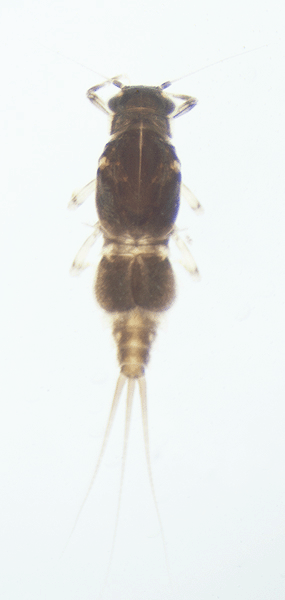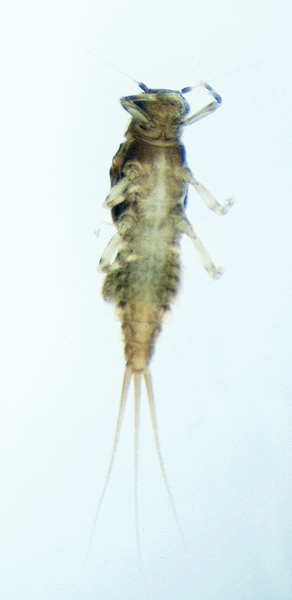Order Ephemeroptera (Mayflies) in the Christopher B. Smith Preserve
Order Ephemeroptera Characteristics: Members of this order have extremely short life spans and emerge from ponds, rivers, and lakes in large numbers in summer months. This is the only insect order in which its members molt after developing functional wings.
The life cycle includes four stages: 1) egg, 2) nymph (aka naiad), 3) subimago, and 4) imago (aka adult). Stage 1: Eggs are laid in water, settle to the bottom, and stick to submerged objects. Most species lay their eggs in freshwater, but a few can tolerate brackish estuaries. Stage 2: Eggs hatch in ~2 weeks and a nymph emerges. Many molts may occur in the nymph stage. This stage lasts two weeks to two years, depending on the species and the environment. Stage 3: At the end of this stage, the skin splits down the back and a winged form (subimago) emerges. It flies from the water surface to a sheltered resting place. Stage 4: After an interval that lasts a few minutes to several days, the skin is shed for the last time, and the winged adult emerges. Common names for adults include spinner, shadfly, sandfly, dayfly, fishfly, and drake. Mating occurs very soon after the adult stage begins. In most species death follows mating and oviposition.
Each of the 6 legs of a naiad end in a single terminating claw. The thoracic region is rounded outward and has external pads that bear the developing wings. The abdomen is long and slender. Gills are on the upper surface of some of the body segments. The body terminates in 2 or three tails.
Adults have large compound eyes, short, bristle-like antennae, and non-functioning mouthparts and digestive tracts. Adults do not eat. Their wings are membranous. Front wings are large and triangular; hind wings are smaller and rounded. When at rest, wings are held together upright over the body. Adult mayflies have two or three, long threadlike tails.
Worldwide there are 2,500 species, about 700 in North America north of Mexico.
Interactions in the Smith Preserve: Mayflies are important in the energy transfer cycle in freshwater. The naiads of some species are carnivorous, but most feed on diatoms, algae, higher plants, and organic detritus. Mayflies are food for carnivorous animals (birds, bats, predatory insects, spiders, mammals, and especially fishes).
Family |
Species Name |
Common Name |
Caenidae |
Caenis sp. |
Angler's Curses |
Caenis sp. Angler's Curses
|
© Photographs and text by Susan Leach Snyder (Conservancy of Southwest Florida Volunteer), unless otherwise credited above.


